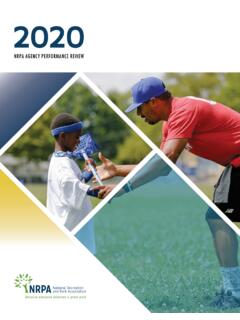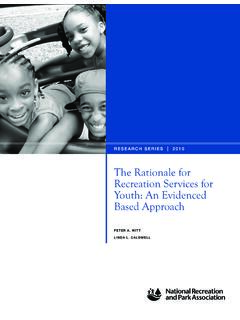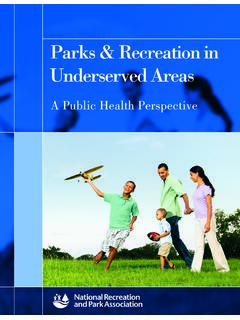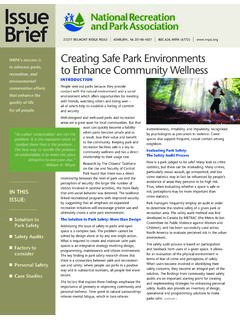Transcription of PARK AND RECREATION SUSTAINABILITY PRACTICES
1 A SUMMARY OF RESULTS FROM AN NRPA MEMBER SURVEYPARK AND RECREATION SUSTAINABILITY AND RECREATION SUSTAINABILITY PRACTICES2 AND RECREATION SUSTAINABILITY PRACTICES3 What is SUSTAINABILITY ? SUSTAINABILITY is a broad term most often defined as meeting the needs of the present without compromising the ability of future generations to meet their needs (Bruntland Report for the World Commission on Environment and Development 1992). Increasingly, as we compete for space and resources, incorporating SUSTAINABILITY principles into our work is no longer something nice to strive for but something we must strive for the benefit of future generations.
2 SUSTAINABILITY is one piece of the puzzle as communities seek to be more resilient to climate and RECREATION agencies are on the front line of a multitude of issues within and outside of the communi-ties they serve. From matters of health and wellness to social equity, conservation and SUSTAINABILITY , critical topics such as these are addressed daily by park and RECREATION agencies across the country. SUSTAINABILITY weaves itself through all those facets. Increasing foot and bike trail access benefits a population s health and wellness while cutting down on the need for driving. Increasing tree canopy and green space in otherwise urban landscapes provide underserved communities with direct access to the physical and mental benefits of nature.
3 Taking measures to mitigate the effects of natural disasters through the use of water diversion tac-tics or shelter accessibility catapults park and RECREATION agencies from simple areas of play and relaxation to major agents of change in a community. Sustainable actions and activities make all these and countless other instances limited resources, it can be a heavy lift for park and RECREATION agencies to incorporate principles of sus-tainability into their operations, programs and management . NRPA remains committed to supporting park and RECREATION agencies in meeting this challenge. As part of its three-year strategic plan, NRPA is encouraging park and RECREATION agencies to engage 1,000 communities in the implementation of sustainable PRACTICES .
4 The NRPA Research team worked closely with the association s conservation team to develop a survey to gain an understanding of the SUSTAINABILITY PRACTICES currently implemented by park and RECREATION agencies and of how agencies are contributing to SUSTAINABILITY in their communities. The survey generated responses from 377 park and RECREATION agencies, resulting in a 12 percent response rate. The key findings from the survey are the basis of this SURVEY HIGHLIGHTS INCLUDE: Park and RECREATION agencies SUSTAINABILITY activities not only focus on environmental benefits but also on public education and cost savings.
5 Even though virtually all park and RECREATION agencies have implemented many SUSTAINABILITY measures, most agencies do not have a documented SUSTAINABILITY plan. Most park and RECREATION agencies do not closely track the cost savings that sustainable actions may generate. Barriers that keep agencies from implementing more SUSTAINABILITY measures include a lack of funding, a lack of dedicated staff and limited expertise on AND RECREATION SUSTAINABILITY PRACTICES4In their role as stewards of the environment, virtually all park and RECREATION agencies support activities that improve SUSTAINABILITY in their communities.
6 These activities can span from educating and connecting the public with nature to reducing negative impacts on the , park and RECREATION agencies less frequently have a formally documented plan that outlines a strategy for preserving natural resources and promoting good conservation and SUSTAINABILITY PRACTICES . In fact, of the surveyed park and RECREATION agencies, just 23 percent currently have a documented sus-tainability plan, although another 11 percent of agencies intend to put into place a formalized SUSTAINABILITY plan within the next year. In some cases, where the agency does not have its own SUSTAINABILITY plan, it follows the strategies and tactics dictated by the city/town, county or state plan (14 percent).
7 But, in many other cases, park and RECREATION agencies do not have a plan at the agency level or elsewhere that guides the SUSTAINABILITY activities for the agency (44 percent). AGENCIES WITH A DOCUMENTED SUSTAINABILITY PLAN(PERCENT DISTRIBUTION)AGENCY SUSTAINABILITY PLANSPARK AND RECREATION SUSTAINABILITY PRACTICES5 Regardless of whether they have a formally documented plan, park and RECREATION agencies invest in sustain-ability PRACTICES with many goals in mind. Naturally, the most widely cited goal is the environmental benefits that these activities and PRACTICES can generate (84 percent of agencies).
8 These may include improving the air and water quality in the community and reducing the agency s impact on the environment ( , using fuel-efficient vehicles, reducing the use of pesticides). Beyond environmental benefits, SUSTAINABILITY activities generate other benefits valued by both the agency and the community. Other widely cited goals of park and RECREATION agency SUSTAINABILITY activities include:84 percent of agencies invest in SUSTAINABILITY activities and PRACTICES for the environmental AND RECREATION SUSTAINABILITY PRACTICES6 Park and RECREATION agencies implement a wide variety of sustainable PRACTICES in their communities.
9 Widely cited SUSTAINABILITY activities implemented by park and RECREATION agencies include: Providing opportunities for healthy activity in nature (81 percent of agencies) Protecting and managing wildlife and wildlife habitats (71 percent) Natural land management (70 percent) Reducing landfill waste (60 percent) Following environmentally friendly building PRACTICES (56 percent) Fostering public engagement and education (52 percent) Implementing green infrastructure PRACTICES (51 percent) SUSTAINABILITY ACTIVITIES PARK AND RECREATION AGENCIES SUSTAINABILITY ACTIVITIES(PERCENT OF AGENCIES)
10 PARK AND RECREATION SUSTAINABILITY PRACTICES7To meet their SUSTAINABILITY goals, park and RECREATION agencies implement a wide variety of activities, policies and strategies. Some of these actions involve altering purchasing policies for more environmentally friendly goods and services. Other tactics involve a greater investment in infrastructure, education and strategic vi-sion. All of these activities have a wide range of HEALTHY ACTIVITIES IN NATUREP romoting healthy activities in nature not only benefits the population physically and mentally but also contributes to a healthier environment.










